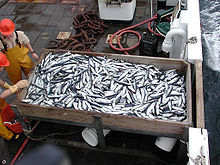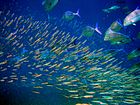Herring: Difference between revisions
Epipelagic (talk | contribs) →As food: main |
Epipelagic (talk | contribs) replace taxobox with image. Old box transfered to Clupea |
||
| Line 1: | Line 1: | ||
{{more footnotes|date=May 2011}} |
|||
{{About|the species of fish}} |
{{About|the species of fish}} |
||
[[File:Atlantic herring 2.gif|thumb|260px|right|<center>Atlantic herring</center>]] |
|||
{{Taxobox |
|||
[[File:Heringsschwarm.gif|thumb|260px|right|<center>Video loop of a school of Atlantic herring migrating to their spawning grounds in the [[Baltic Sea]]]] |
|||
| name = Herring |
|||
| fossil_range = {{fossilrange|55|0}} <br>Early [[Eocene]] to Present<ref>{{cite journal |
|||
| last = Sepkoski |
|||
| first = Jack |
|||
| authorlink = |
|||
| coauthors = |
|||
| title = A compendium of fossil marine animal genera |
|||
| journal = Bulletins of American Paleontology |
|||
| volume = 364 |
|||
| issue = |
|||
| pages = 560 |
|||
| publisher = |
|||
| location = |
|||
| year = 2002 |
|||
| url = http://strata.ummp.lsa.umich.edu/jack/showgenera.php?taxon=611&rank=class |
|||
| doi = |
|||
| id = |
|||
| accessdate = 2007-12-25 }}</ref> |
|||
| image = Herringadultkils.jpg |
|||
| image_caption = Atlantic Herring |
|||
| regnum = [[Animal]]ia |
|||
| phylum = [[Chordata]] |
|||
| classis = [[Actinopterygii]] |
|||
| subclassis = [[Neopterygii]] |
|||
| infraclassis = [[Teleostei]] |
|||
| ordo = [[Clupeiformes]] |
|||
| familia = [[Clupeidae]] |
|||
| subfamilia = [[Clupeinae]] |
|||
| genus = '''''Clupea''''' |
|||
| genus_authority = [[Carolus Linnaeus|Linnaeus]], 1758 |
|||
| subdivision_ranks = Species |
|||
| subdivision = see text |
|||
}} |
|||
'''Herring''' is an [[oily fish]]<ref>{{cite news|url=http://www.food.gov.uk/news/newsarchive/2004/jun/oilyfishdefinition|title=What's an oily fish?|date=2004-06-24|publisher=[[Food Standards Agency]]}}</ref> of the genus ''Clupea'', found in the shallow, temperate waters of the North [[Pacific Ocean|Pacific]] and the North [[Atlantic Ocean|Atlantic]] oceans, including the [[Baltic Sea]]. Three species of ''Clupea'' are recognized. The main taxa, the [[Atlantic herring]] (''Clupea harengus'') and the [[Pacific herring]] (''Clupea pallasii'') may each be divided into subspecies. Herrings are [[forage fish]] moving in vast [[Shoaling and schooling|schools]], coming in spring to the shores of [[Europe]] and [[Americas|America]], where they are caught, salted, [[smoked fish|smoked]], marinated and creamed. |
'''Herring''' is an [[oily fish]]<ref>{{cite news|url=http://www.food.gov.uk/news/newsarchive/2004/jun/oilyfishdefinition|title=What's an oily fish?|date=2004-06-24|publisher=[[Food Standards Agency]]}}</ref> of the genus ''Clupea'', found in the shallow, temperate waters of the North [[Pacific Ocean|Pacific]] and the North [[Atlantic Ocean|Atlantic]] oceans, including the [[Baltic Sea]]. Three species of ''Clupea'' are recognized. The main taxa, the [[Atlantic herring]] (''Clupea harengus'') and the [[Pacific herring]] (''Clupea pallasii'') may each be divided into subspecies. Herrings are [[forage fish]] moving in vast [[Shoaling and schooling|schools]], coming in spring to the shores of [[Europe]] and [[Americas|America]], where they are caught, salted, [[smoked fish|smoked]], marinated and creamed. |
||
| Line 116: | Line 83: | ||
==Ecology== |
==Ecology== |
||
{{Ref improve section|date=February 2011}} |
|||
''See [[Atlantic herring]] for videos of juvenile herring feeding by catching [[copepod]]s.'' |
''See [[Atlantic herring]] for videos of juvenile herring feeding by catching [[copepod]]s.'' |
||
[[File:Heringsfass.JPG|thumb| |
[[File:Heringsfass.JPG|thumb|right|Clupea harengus]] |
||
[[File:Heringsschwarm.gif|thumb|200px|left|An underwater video of a school of herring.]] |
|||
[[Predator]]s of herring include [[humans]], [[seabirds]], [[dolphins]], [[porpoises]], [[striped bass]], [[earless seal|seal]]s, [[sea lion]]s, [[whales]], [[sharks]], [[spiny dogfish|dog fish]], [[tuna]], [[cod]], [[salmon]], and [[halibut]]. Other large fish also feed on adult herring. |
[[Predator]]s of herring include [[humans]], [[seabirds]], [[dolphins]], [[porpoises]], [[striped bass]], [[earless seal|seal]]s, [[sea lion]]s, [[whales]], [[sharks]], [[spiny dogfish|dog fish]], [[tuna]], [[cod]], [[salmon]], and [[halibut]]. Other large fish also feed on adult herring. |
||
| Line 127: | Line 92: | ||
==Fisheries== |
==Fisheries== |
||
[[File:Herring catch-Sep200.jpg|thumb| |
[[File:Herring catch-Sep200.jpg|thumb|right|Commercial herring catch]] |
||
[[File:Iceland-Stamp-1940-Herring.jpg|thumb|180px|right|Postage stamp, Iceland, 1940.]] |
|||
Adult herring are harvested for their meat and eggs, and they are often used as [[Bait fish|baitfish]]. The trade in herring is an important sector of many national economies. In Europe the fish has been called the "silver of the sea", and its trade has been so significant to many countries that it has been regarded as the most commercially important fishery in history.<ref>[http://www.coml.org/discoveries/discoveries/historical/hmap-important.htm Herring], from [http://www.coml.org/about Census of Marine Life], 2010.</ref> |
Adult herring are harvested for their meat and eggs, and they are often used as [[Bait fish|baitfish]]. The trade in herring is an important sector of many national economies. In Europe the fish has been called the "silver of the sea", and its trade has been so significant to many countries that it has been regarded as the most commercially important fishery in history.<ref>[http://www.coml.org/discoveries/discoveries/historical/hmap-important.htm Herring], from [http://www.coml.org/about Census of Marine Life], 2010.</ref> |
||
| Line 145: | Line 110: | ||
==History== |
==History== |
||
[[File: |
[[File:Iceland-Stamp-1940-Herring.jpg|thumb|120px|right|Postage stamp, Iceland, 1940]] |
||
[[File:Olausmagnus scaniamarket.jpg|thumb|left|Medieval herring fishing in [[Scania Market|Scania]], 1555]] |
|||
{{clear}} |
{{clear}} |
||
Revision as of 04:00, 9 April 2012


Herring is an oily fish[1] of the genus Clupea, found in the shallow, temperate waters of the North Pacific and the North Atlantic oceans, including the Baltic Sea. Three species of Clupea are recognized. The main taxa, the Atlantic herring (Clupea harengus) and the Pacific herring (Clupea pallasii) may each be divided into subspecies. Herrings are forage fish moving in vast schools, coming in spring to the shores of Europe and America, where they are caught, salted, smoked, marinated and creamed.
Morphology
The species of Clupea belong to the larger family Clupeidae (herrings, shads, sardines, menhadens), which comprise some 200 species that share similar features. These silvery-colored fish have a single dorsal fin, which is soft, without spines. They have no lateral line and have a protruding lower jaw. Their size varies between subspecies: the Baltic herring (Clupea harengus membras) is small, 14 to 18 centimeters; the proper Atlantic herring (C. h. harengus) can grow to about 46 cm (18 inches) and weigh up 700 g (1.5 pounds); and Pacific herring grow to about 38 cm (15 inches).
Species
| True herring species | |||||||||
|---|---|---|---|---|---|---|---|---|---|
| Common name | Scientific name | Maximum length |
Common length |
Maximum weight |
Maximum age |
Trophic level |
FishBase | FAO | IUCN status |
| Araucanian herring | Clupea bentincki Norman, 1936 | 28.4 cm | cm | kg | years | 2.69 | [2] | [3] | Not assessed |
| Atlantic herring | Clupea harengus Linnaeus, 1758 | 45.0 cm | 30.0 cm | 1.05 kg | 22 years | 3.23 | [4] | [5] | |
| White Sea herring | Clupea pallasii marisalbi L. S. Berg, 1923 | 34.0 cm | Not assessed | ||||||
| Pacific herring | Clupea pallasii pallasii Valenciennes, 1847 | 46.0 cm | 25.0 cm | 19 years | 3.15 | [7] | [8] | Not assessed | |
| Chosa herring | Clupea pallasii suworowi Rabinerson, 1927 | 31.5 cm | [9] | Not assessed | |||||
Ecology
See Atlantic herring for videos of juvenile herring feeding by catching copepods.

Predators of herring include humans, seabirds, dolphins, porpoises, striped bass, seals, sea lions, whales, sharks, dog fish, tuna, cod, salmon, and halibut. Other large fish also feed on adult herring.
Young herring feed on phytoplankton and as they mature they start to consume larger organisms. Adult herring feed on zooplankton, tiny animals that are found in oceanic surface waters, and small fish and fish larvae. Copepods and other tiny crustaceans are the most common zooplankton eaten by herring. During daylight herring stay in the safety of deep water, feeding at the surface only at night when there is less chance of being seen by predators. They swim along with their mouths open, filtering the plankton from the water as it passes through their gills.
Fisheries

Adult herring are harvested for their meat and eggs, and they are often used as baitfish. The trade in herring is an important sector of many national economies. In Europe the fish has been called the "silver of the sea", and its trade has been so significant to many countries that it has been regarded as the most commercially important fishery in history.[10]
Environmental Defense have suggested that the Atlantic herring (Clupea harengus) fishery is one of the more environmentally responsible fisheries.[11]
As food

Herring has been a staple food source since at least 3000 B.C. There are numerous ways the fish is served and many regional recipes: eaten raw, fermented, pickled, or cured by other techniques.
Herring are very high in the long-chain Omega-3 fatty acids EPA and DHA.[12] They are a source of vitamin D.
Water pollution influences the amount of herring that may be safely consumed. For example, large Baltic herring slightly exceeds recommended limits with respect to PCB and dioxin, although some sources point out that cancer-reducing effect of omega-3 fatty acids is statistically stronger than the cancer-causing effect of PCBs and dioxins.[13] The contaminant levels depend on the age of the fish which can be inferred from their size. Baltic herrings larger than 17 cm may be eaten twice a month, while herrings smaller than 17 cm can be eaten freely.[14] Mercury in fish also influences the amount of fish that women who are pregnant or planning to be pregnant within the next one or two years may safely eat.
History


See also
- Atlantic herring
- Soused herring
- Shmaltz herring
- Brathering
- Scania Market
- Kipper
- Underwater video (looping) of a school of Atlantic herring Clupea harengus on its migration to their spawning grounds in the Baltic Sea.
Notes
- ^ "What's an oily fish?". Food Standards Agency. 2004-06-24.
- ^ Froese, Rainer; Pauly, Daniel (eds.) (2012). "Clupea bentincki" in FishBase. April 2012 version.
- ^ Clupea bentincki (Norman, 1936) FAO, Species Fact Sheet. Retrieved 2 March 2012.
- ^ Froese, Rainer; Pauly, Daniel (eds.) (2012). "Clupea harengus" in FishBase. April 2012 version.
- ^ Clupea harengus ((Linnaeus, 1758) FAO, Species Fact Sheet. Retrieved 2 March 2012.
- ^ Template:IUCN2011.2
- ^ Froese, Rainer; Pauly, Daniel (eds.) (2012). pallasii"Clupea pallasii pallasii" in FishBase. April 2012 version.
- ^ Clupea pallasii (Valenciennes, 1847) FAO, Species Fact Sheet. Retrieved 2 March 2012.
- ^ Froese, Rainer; Pauly, Daniel (eds.) (2012). "Clupea pallasii+suworowi" in FishBase. April 2012 version.: "Status needs confirmation."
- ^ Herring, from Census of Marine Life, 2010.
- ^ Eco-Best Fish - Safe for the environment, from Environmental Defense Fund, 2010.
- ^ Cardiovascular Benefits Of Omega-3 Fatty Acids Reviewed
- ^ Risks and benefits are clarified by food risk assessment - Finnish Food Safety Authority Evira
- ^ Dietary advice on fish consumption - Finnish Food Safety Authority Evira
References
- Froese, Rainer and Pauly, Daniel, eds. (2006). Species of Clupea in FishBase. January 2006 version.
- O'Clair, Rita M. and O'Clair, Charles E., "Pacific herring," Southeast Alaska's Rocky Shores: Animals. pg. 343-346. Plant Press: Auke Bay, Alaska (1998). ISBN 0-9664245-0-6
External links
- Herring "communicate" by flatulence from national geographic
- Atlantic Herring from the Gulf of Maine Research Institute
- Nutrition Facts for Herring




